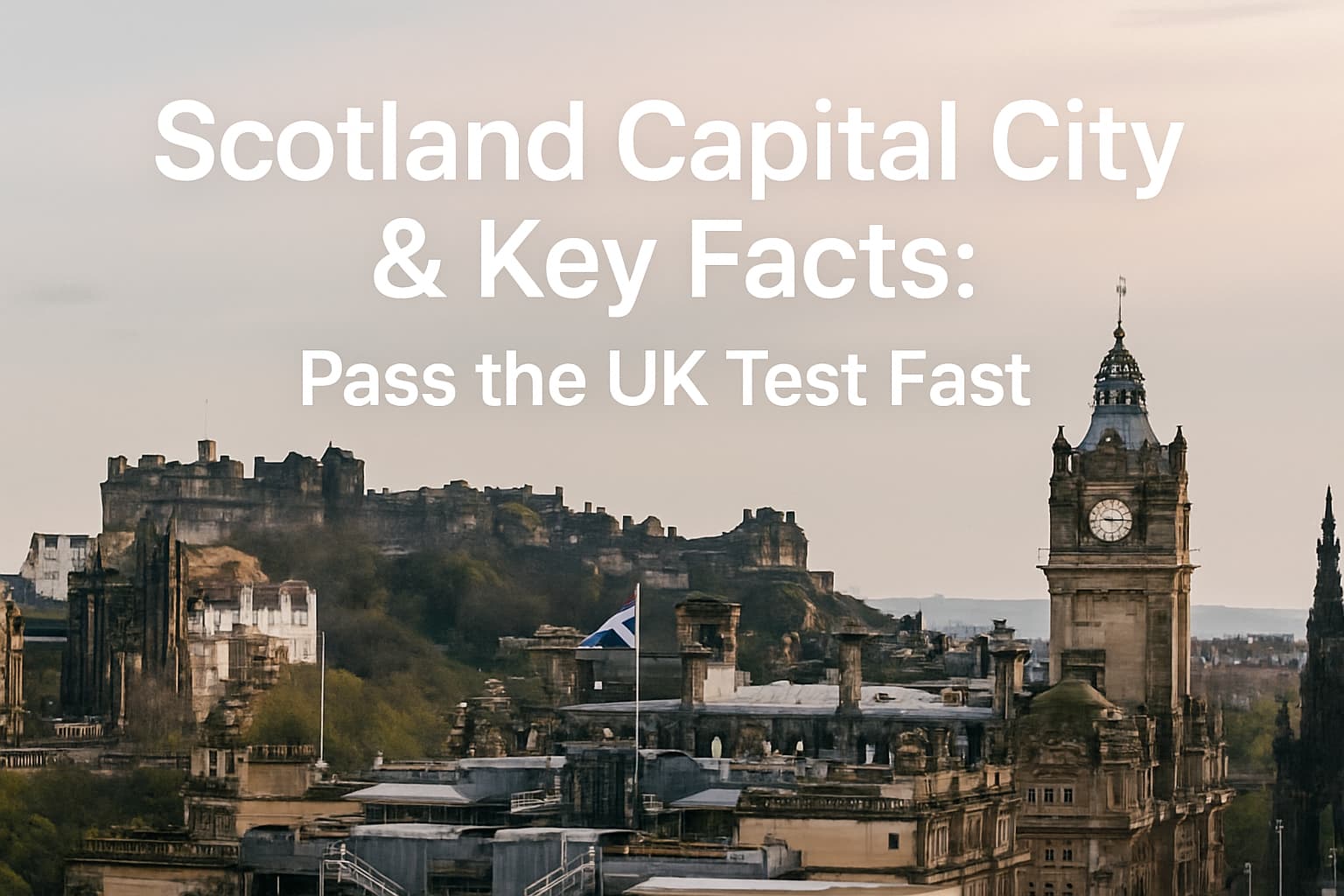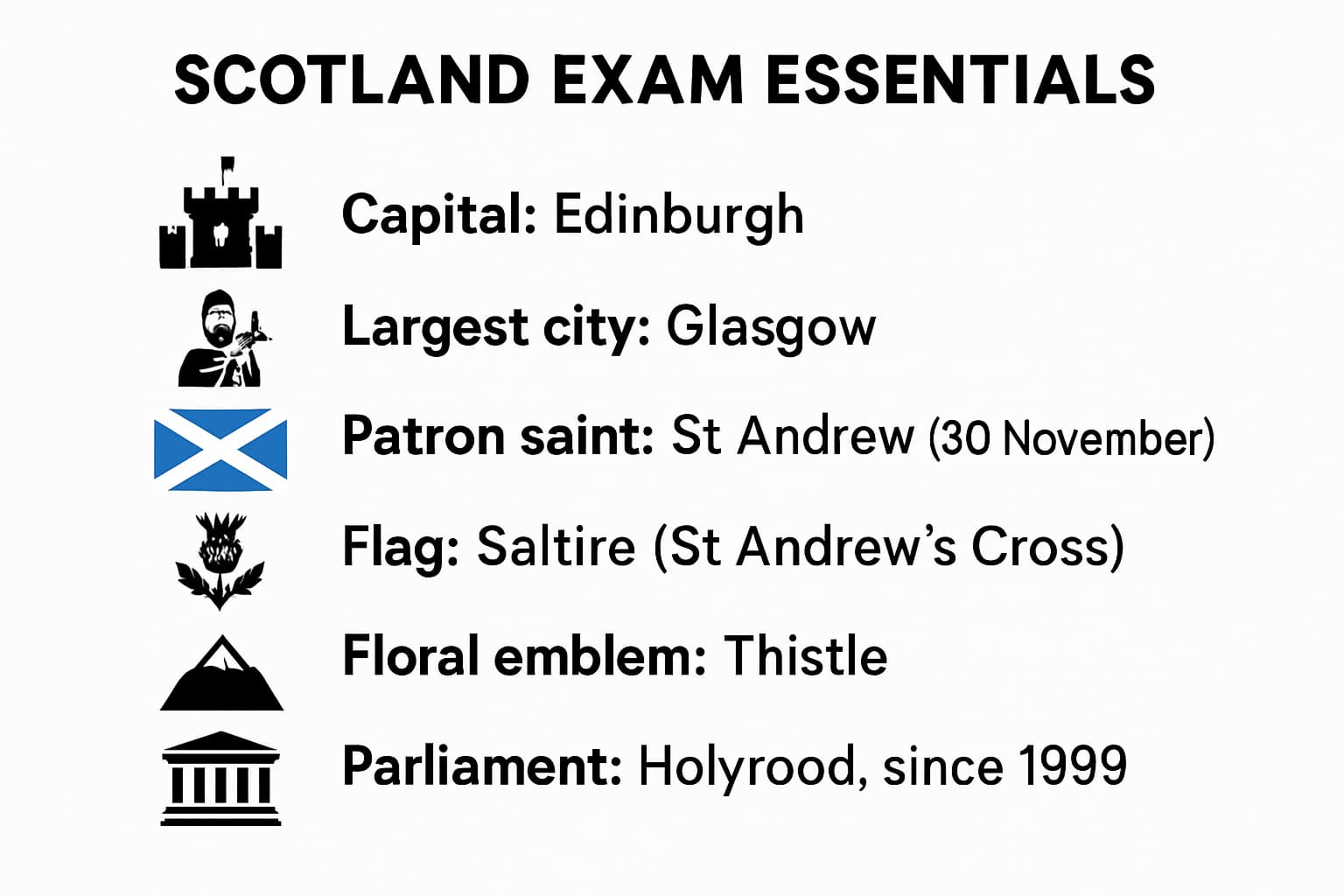Scotland Capital City & Key Facts: Pass the UK Test Fast

Struggling to recall the Scotland capital city, patron saint, or the order of key unions? This focused guide distills exactly what the Life in the UK Test asks about Scotland — nothing more, nothing less.
Use it to lock in high-yield facts, skim a rapid checklist, and drill with the Life in the UK Test App so you pass first time.
We follow the official handbook (A Guide for New Residents, 3rd edition) and show you how to revise smarter, not longer.
What the Life in the UK test expects on Scotland
The handbook highlights a compact set of Scotland facts. Most questions test place names, symbols, dates, and how Scotland fits into the UK. If you can recall the capital, major regions, national symbols, patron saint and date, core history milestones, and the basics of devolution, you will be ready.
Know on sight: Scotland capital city, largest city, main regions, iconic landmarks.
Dates and symbols: St Andrew, St Andrew’s Day, Saltire, thistle.
Government basics: Scottish Parliament at Holyrood since 1999; devolved powers.
History sequence: Wars of Independence; 1603 Union of the Crowns; 1707 Acts of Union; modern devolution.
Culture touchpoints: Robert Burns and Burns Night; Hogmanay; Scotland’s link to golf.
If you are new to the test format, start with this overview of what the Life in the UK Test is.
How Scotland fits into the UK content map
Scotland is one of the UK’s four countries and a devolved nation with its own parliament and systems in certain areas. The exam expects precise recall of which facts belong to Scotland versus England, Wales, or Northern Ireland. Small mix-ups (like capital versus largest city) are common traps.
High-yield fact types you’ll see
Cities and regions: capital, largest city, Highlands/Lowlands, islands.
National symbols: patron saint, flag, floral emblem.
Dates and events: battles and unions in the right order.
Government and law: devolution since 1999; distinct legal/education systems.
Culture: Burns Night (25 January), Hogmanay, golf’s origins.
For a broader exam plan, see our concise Life in the UK Test study guide.

Scotland capital city and essential geography
Expect straightforward recall questions about places. The handbook emphasises capitals, major cities, regions, and famous natural landmarks.
Scotland capital city: Edinburgh
Definition: The Scotland capital city is Edinburgh, home to the Scottish Parliament at Holyrood.
Edinburgh is the political capital and seat of devolved government.
Do not confuse it with Glasgow, which is larger by population.
Beyond the test, modern Edinburgh consistently ranks highly for quality of life and green space, reinforcing its prominence today according to Edinburgh Council.
Major cities and regions to recognise
Glasgow: Scotland’s largest city, major cultural and economic centre.
Aberdeen: key city in the northeast, known for energy industries.
Highlands and Lowlands: two broad regions commonly mentioned.
Island groups: the Shetland and Orkney Islands (north of mainland Scotland).
Landmarks and superlatives
Ben Nevis: highest mountain in the UK (in the Highlands).
Loch Lomond: one of the largest lochs; the handbook highlights it among key British lakes.
Loch Ness: famous for legend and often name-checked in culture and geography questions.
Symbols, flag, and patron saint of Scotland
Symbol and date questions are frequent. Know the patron saint and St Andrew’s Day, plus the national flag and floral emblem.
Patron saint of Scotland: St Andrew (30 November)
Definition: The patron saint of Scotland is St Andrew. St Andrew’s Day is 30 November.
St Andrew is traditionally linked with an X-shaped cross; the white cross on the flag reflects this association. The day is widely marked in Scotland and in other countries where he is patron as noted by the UK Foreign, Commonwealth and Development Office. For background on the X-shaped cross tradition, see this overview in the Independent.
Flag and floral emblem
Flag: the Saltire (St Andrew’s Cross) — a white diagonal cross on a blue field.
Floral emblem: the thistle.
Government, law, and education in Scotland
Know what devolution changed, the location of the Parliament, and which systems remain distinct.
Scottish Parliament at Holyrood (since 1999)
1999 devolution: The Scottish Parliament was established and sits at Holyrood in Edinburgh.
Powers: devolved responsibilities include areas like education, health, and certain aspects of transport and justice (test-level detail).
Distinct legal and education systems
Scots law: Scotland has a separate legal system from the rest of the UK.
Education: Scotland’s education system also differs — a common exam question theme.
Scottish history milestones the test covers
Sequence and cause-effect are key. Expect questions on national figures, pivotal battles, and the two unions that formed modern Great Britain.
Wars of Independence and national figures
William Wallace and Robert the Bruce are central figures in the struggle for independence.
Bannockburn (1314): a major Scottish victory under Robert the Bruce.
Union of the Crowns (1603) and Acts of Union (1707)
Remember this order:
1603 Union of the Crowns: Scotland and England came under one monarch.
1707 Acts of Union: political union created the Kingdom of Great Britain with a single Parliament at Westminster.
Modern Scotland and devolution
Devolution returned in 1999 with the creation of the Scottish Parliament at Holyrood, giving Scotland legislative powers in devolved areas and shaping today’s UK constitutional landscape.
For wider historical context that often feeds exam questions, see our guide from the English Civil War to 1688.
Culture and traditions likely to be asked
Culture questions tend to be direct: person, event, and date. Know these and you’ll score easy marks.
Robert Burns and Burns Night (25 January)
Robert Burns: Scotland’s national poet.
Burns Night: celebrated on 25 January with poetry, music, and traditional food.
Hogmanay and Scottish New Year customs
Hogmanay is the Scottish term for New Year celebrations, marked by distinctive customs and public events.
Sport and world influence
Golf has strong Scottish roots, with the town of St Andrews often associated with the game. Sports questions may connect the UK’s sporting heritage back to Scotland.
Broaden your festival and culture coverage using our quick guide to UK festivals you must know.
Rapid-fire revision: Scotland facts checklist
Use this one-glance list for last-minute review before mocks or test day.
10 must-remember items
Scotland capital city: Edinburgh.
Largest city: Glasgow.
Patron saint of Scotland: St Andrew.
St Andrew’s Day: 30 November.
Flag: the Saltire (St Andrew’s Cross).
Floral emblem: the thistle.
Highest mountain in the UK: Ben Nevis (Scotland).
Key regions: Highlands and Lowlands; island groups include Shetland and Orkney.
Parliament returned in 1999 at Holyrood, Edinburgh.
Unions in order: 1603 Union of the Crowns, then 1707 Acts of Union.
Mini self-test (true/false and one-word)
True or false: Glasgow is the capital. False.
One word: Scotland’s floral emblem. Thistle.
True or false: St Andrew’s Day is in November. True.
One word: Scotland’s flag. Saltire.
True or false: The Scottish Parliament sits at Westminster. False.
Study smarter with the Life in the UK Test App
Most candidates fail from overload, not difficulty. The Life in the UK Test App fixes the biggest hurdles:
Too much content? Brit-Bear turns the full official handbook into short, adaptive drills.
Running out of time? A readiness score shows when you can pass — and where to focus.
Weak on dates and symbols? Over 650 questions with explanations target facts like Edinburgh, St Andrew, 1707, and Ben Nevis.
Nerves on test day? Mock tests with Hard Mode simulate the real exam.
On the go? Full offline access means you can revise anywhere.
Target Scotland items with Brit-Bear and Hard Mode
Open the Scotland deck and let Brit-Bear adaptively repeat high-yield cards until recall is instant (capital, patron saint, Saltire, thistle, 1603/1707). Then switch to Hard Mode mocks to stress-test your memory under time pressure. If your readiness score dips on Scotland topics, the app auto-serves micro-lessons.
Avoid common study pitfalls with these tips and our guide to Life in the UK Test mistakes to avoid.
Start now (iOS & Android)
Practice the exact Scotland questions you’ve just reviewed:
FAQs
What is the Scotland capital city?
Edinburgh is the capital, home to the Scottish Parliament at Holyrood.
Who is the patron saint of Scotland and when is the day?
St Andrew; St Andrew’s Day is 30 November.
Which is Scotland’s largest city?
Glasgow is the largest city by population.
What are Scotland’s national symbols?
The Saltire (St Andrew’s Cross) and the thistle.
When did Scotland get a devolved parliament?
In 1999; the Scottish Parliament sits at Holyrood in Edinburgh.
What key unions must I remember?
1603 Union of the Crowns, then 1707 Acts of Union creating Great Britain.